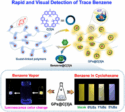Scintillators are materials that can convert radiation such as, e.g., X-rays into visible light. Large-area scintillation screens are needed, e.g., in medical imaging and for industrial inspections. However, large-area scintillation crystals are difficult to grow.
Dai-Bin Kuang, Sun Yat-Sen University, China, and colleagues have synthesized the manganese-based metal halide (HTPP)2MnBr4 (HTPP = hexyltriphenylphosphonium). This metal halide can be converted into a large-area glass using a melt-quenching method. Since organic-inorganic metal halides usually decompose before melting, it is difficult for them to transition from the crystalline to the glassy state. To solve this issue, the team introduced the organic cation hexyltriphenylphosphonium. This bulky organic cation can lower the melting point and reduce the crystallization tendency during quenching.
The team first synthesized single crystals via a slow solvent evaporation method. The prepared crystals were then heated to 220 °C and naturally cooled to room temperature to form a glass. The developed metal halide glass can be used as a large-area scintillation screen for radiation detection and X-ray imaging.
Metal halide glass can combine the advantages of excellent luminescent properties with the ease of mass production. This combination could allow the commercialization of metal halide luminescent materials.
- A Melt‐Quenched Luminescent Glass of an Organic‐Inorganic Manganese Halide as a Large‐Area Scintillator for Radiation Detection,
Jian-Bin Luo, Jun-Hua Wei, Zhi-Zhong Zhang, Zi-Lin He, Dai-Bin Kuang,
Angew. Chem. Int. Ed. 2022.
https://doi.org/10.1002/anie.202216504




